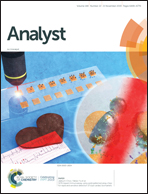Enzyme-linked immunosorbent assay utilizing thin-layered microfluidics
Abstract
A rapid and sensitive enzyme-linked immunosorbent assay (ELISA) is required for on-site clinical diagnosis. Previously, a microfluidic ELISA in which antibody-immobilized beads are packed in a microchannel for a high surface-to-volume (S/V) ratio was developed, but utilizing beads led to complicated fluidic operation. Recently, we have reported nanofluidic ELISA that utilizes antibody-immobilized glass nanochannels (102–103 nm) to achieve a high S/V ratio without beads, enabling even single-molecule detection, but it is not applicable to clinical diagnosis owing to its fL sample volume, much smaller than the nL–μL sample volume in clinical diagnosis. Here, we propose an antibody-immobilized, thin-layered microfluidic channel as a novel platform. Based on the method of nanofluidic ELISA, the channel width was expanded from 103 nm to 100 mm to expand the volume of the reaction field to 102 nL, while the channel depth (103 nm) was maintained to retain the high S/V ratio. A device design which incorporates a taper-shaped interface between the thin-layered channel and the microchannel for sample injection was proposed, and the uniform introduction of the sample into the high-aspect-ratio (width/depth ∼ 200) channel was experimentally confirmed. For the proof of concept, a thin-layered ELISA device with the same S/V ratio as the bead-based ELISA format was designed and fabricated. By measuring a standard C-reactive protein solution, the working principle was verified. The limit of detection was 34 ng mL−1, which was comparable to that of bead-based ELISA. We believe that the thin-layered ELISA can contribute to medicine and biology as a novel platform for sensitive and rapid ELISA.



 Please wait while we load your content...
Please wait while we load your content...
